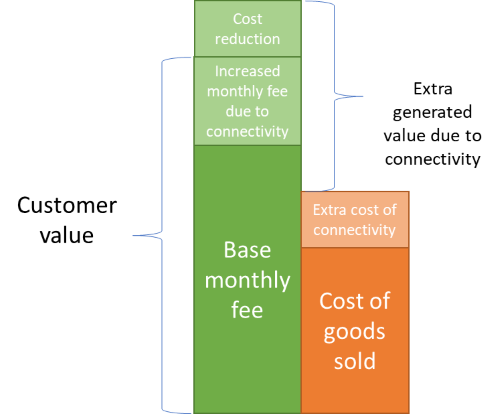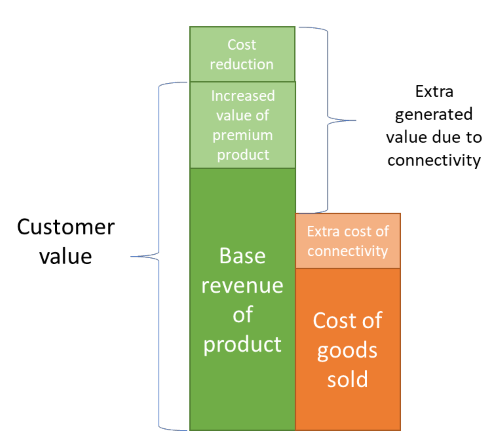Navigating IoT and Digital Transformation (IoT Tutorial, Chapter 4)
In this chapter, IoT and Digital Transformation, we will look at how different companies may use IoT to enhance their business model and form their value proposition to the customers. Explore additional insights on our IoT tutorial page, including the full-length video tutorial.
There are many examples of companies that apply IoT as a part of their business model from the start, but the real challenge is transforming from a traditional business model to one that includes IoT.
Let’s look into the challenges that might be encountered in such a transformation and the role of IoT in digital transformation.
Unveiling a New Value Proposition through IoT Digitization
Take a well-known product like a car. When we update this car with IoT technology (sensor, microprocessor, a radio module, connect it to a server backend, add an app/user interface to this), we add a layer of digitization on top of the traditional product.
From this stage, we take the first steps to a new value proposition, which means that the product is more than just the physical car. We have increased the value of the car by adding IoT and making data and more functions available to the customer.
Another example could be your home alarm where the home alarm provider is continuously adding more services to their portfolio. The home alarm and its sensors are at the core, but as a customer, you also get access to temperature data, the possibility to remotely control your lights, and much more.
How Do Companies Apply IoT in Their Business Model?
How do companies apply IoT in their business model? Are there differences in how companies approach IoT and connectivity in their products?
Well, yes of course there are. We have seen several examples of benefits that can be utilized by applying a layer of connectivity to a product or a service, and now we will go deeper into the different value chains that can be a part of IoT, and how different companies may have different approaches to reap the benefits of connectivity.
Navigating IoT Business Models from Seamless Integration to Elevated Customer Loyalty
Let’s go back to our example with home alarms. As most of you may know, a home alarm typically comes with a subscription model. You pay for the installation of cameras, motion sensors, and fire detectors, and then you pay a monthly fee to keep the services up and running, also covering potential emergency services.
In this case, applying and adopting the benefits of connectivity is quite straightforward, as the home alarm company can adjust their pricing towards their customers according to the new value of adding another layer. For the alarm company, the adaptation of an IoT service can be perceived as very smooth. The business case of applying IoT is easily motivated as the service incurs an increased price for the customer, which optimally provides earnings that exceed the extra cost.
Comparing Business Models: Subscription-Based Certainty vs. Premium Product Potential in IoT Connectivity
Not every use case is as straightforward as the home alarms. If you for example can add connectivity to an existing product to make it a premium product in your current offering, you might be able to charge a higher price for the product, but not necessarily have the need of generating recurring income. In other words, you might choose a higher pricing, but no recurring fee for your product.
The connectivity may also simply add “stickiness” or a “wow”-factor to your product enabling higher customer loyalty. Even though the benefits are nice and easily described the business model without recurring fees can be harder to calculate in terms of return on investment. It might be hard to properly predict the revenue for soft values like customer loyalty.
Let’s do a comparison of how companies’ reasoning may vary, depending on their market approach.

As you can see in the subscription-based example, it’s a safe approach as the increased customer value and revenues for the company both increase, and the extra costs are still manageable. The correlation between revenue and costs in this case is directly related, as a revenue-generating subscription is needed for the extra costs to occur.
Each connected product will generate an income from the subscription fee, which will cover the cost of the connectivity. This is of course an oversimplification as there are still research and development costs, marketing costs, and much more before being able to go to market.
But in principle, the certainty of having a reasonable return on investment is more easily calculated.
Let’s look at the same model but without the subscriptions.

At first glance, the models are very similar, as the principle remains. But if you look closely, you may notice that there are no promises of extra long-term revenues in the second case.
You have the same indirect costs of the subscription-based model, meaning R&D, marketing, etc., but you are not able to promise a return on investment based on extra monthly fees. You can of course align the charging of your product with the new premium aspect the connectivity delivers, but how do you take into consideration that you now have a recurring cost, with no corresponding income for the remainder of your product’s life cycle?
In this case, you need to work with other factors, but that doesn’t necessarily mean that the adaptation of connectivity is a bad business case. If you can offer something that the competitors can’t, or won’t, you might create a customer need that in turn creates a loyalty factor.
Let’s take an example where this might be feasible, Applying IoT and connecting a car. A car is, in most cases, already quite expensive, and your customers might not be interested in paying an extra monthly fee. So how might this still end up benefitting your company? Your customers need to feel that a need is fulfilled, and if the experience and perceived value are increased, you might have created a loyalty incentive within your customer base. If adding connectivity means that your customers become loyal and return next time, they are looking for a car, or liking the product so much that they recommend your brand to a friend or colleague, you can reap indirect benefits of a premium product.
If we compare the different models we’ve reviewed so far, we can see that in the subscription-based model, the revenues increase over time as the service is delivered. However, in the premium product-based offering, the return on investment is related to the life span of the product.
So, what does this mean? Is a subscription-based offering always better than adopting connectivity for a premium product? Well, not necessarily. Even though it might be an easier journey and more directly beneficial with an easily projected way forward, the premium product may give a competitive edge to your company, even if it’s hard to spot initially.
Conclusion
We have only scratched the surface of what it means to integrate IoT as part of a business model, and there are of course several other approaches to include IoT as a value proposition. There are different challenges to different business models and many factors to consider when taking a traditional product and adding the digital layer.

